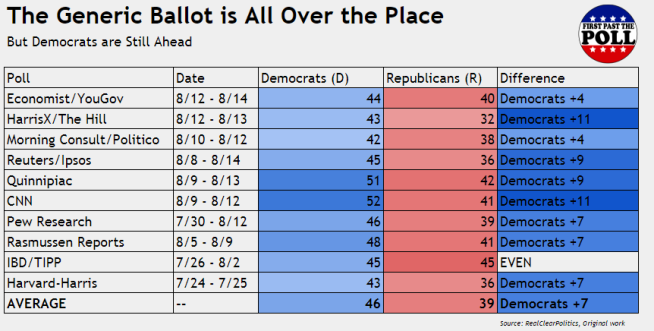Polling 435 different Congressional districts is hard (and expensive)! To streamline the process, pollsters have invented a question that inquires about a “generic ballot.” Instead of asking “Do you prefer [NAME OF DEMOCRATIC CANDIDATE] or [NAME OF REPUBLICAN CANDIDATE]?” and tailoring the name for each district, this question simulates the national popular vote by asking something along the lines of “Which party will you support in the upcoming Congressional election?” In short, it proposes a ballot that’s generic. Wow.
There’s been much debate on the exact utility of the generic ballot, but almost everyone can agree on this: if Democrats want to take back the House, they’ll need anywhere from a 5-8 point lead come November. So, how are they doing?

Right off the bat, these generic ballot questions unanimously indicate that Republicans are playing from behind. Of course, the margin is the important thing to look at, and while there are major disparities, they can be attributed to a) how early in the election cycle we are, and b) different methodologies from different pollsters. Still, the average of D+7 puts them in the middle of their magic margin.
Looking at the longer trend of the generic ballot is ostensibly more worrying for Democrats. Indeed, at the beginning of the summer, they consistently were up by double digits, a far cry from their current 7-point lead. Nevertheless, this shouldn’t be time to pound the alarm, for it’s a classic case of mean reversion. Basically, any major advantage is expected to shrink over time, regardless of who has it.
What can one take away from this as a casual reader and politics follower? My biggest piece of advice is to examine averages, not just one poll. There will almost always be wild deltas, making aggregates much more useful.
Additionally, expect Democrats’ lead to gradually fall, but probably not even out. That goes back to the idea of reverting to the mean. If their average advantage starts dipping precipitously, then it might be time to start reevaluating the race.
Finally, if you’re truly interested in keeping up with the generic ballot, I encourage you to check back often. There a lot of great sites — including RealClearPolitics and FiveThirtyEight — that update their trackers daily and provide commentary on big shifts.
Whichever method(s) you choose to employ, though, remember: the generic ballot question is not a crystal ball that tells us with absolute certainty who will win back the House. Election-watching can be fun and educational, as long as you stay realistic. Sorry for ending this post with such a generic caution, but it’s always important to keep in mind.


3 thoughts on “Generic Ballot Polls Are All Over the Place”